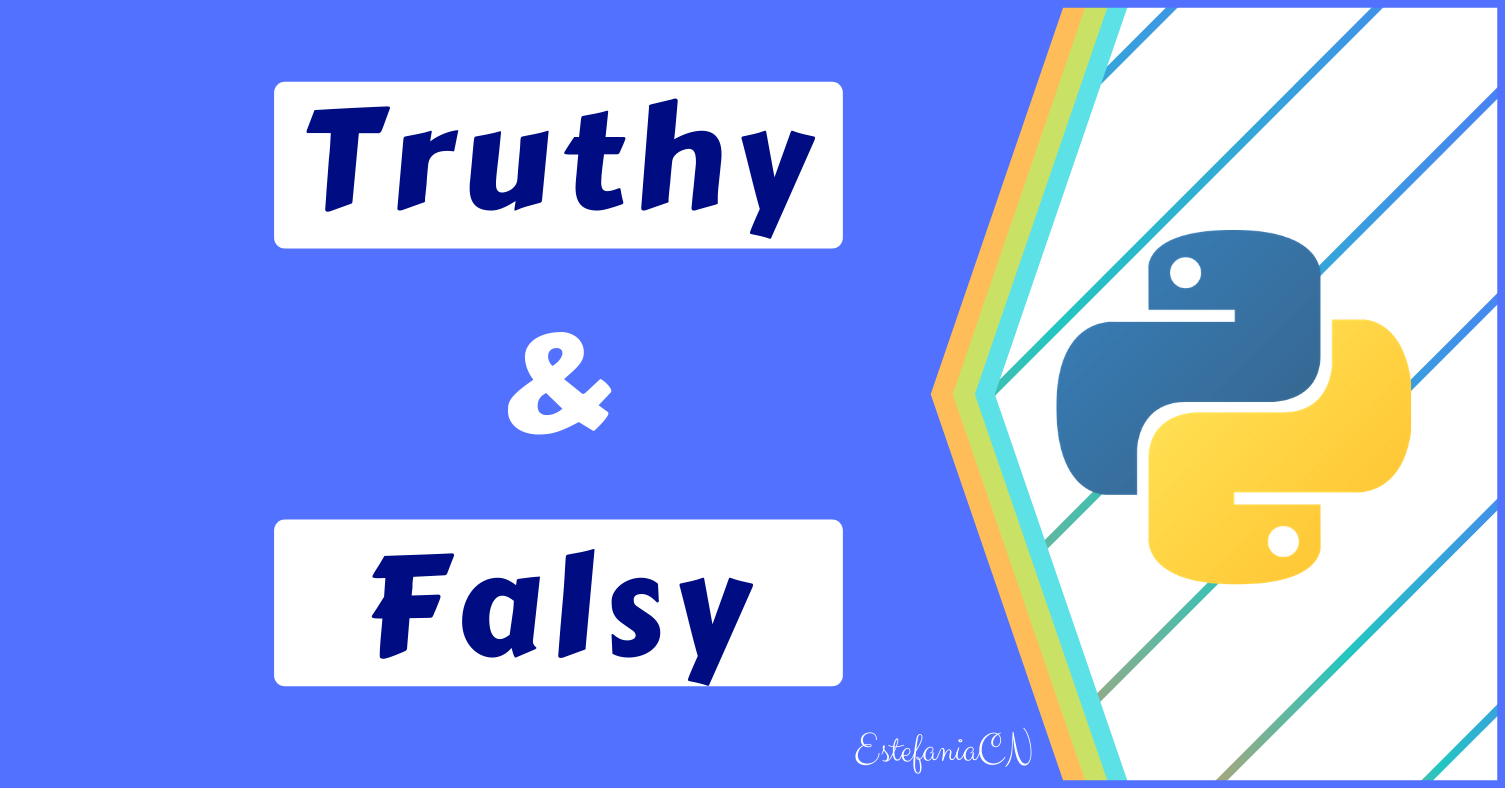Welcome
In this article, you will learn:
- What truthy and falsy values are.
- What makes a value truthy or falsy.
- How to use the
bool()function to determine if a value is truthy or falsy. - How to make objects from user-defined classes truthy or falsy using the special method
__bool __.
Let's begin! ✨
🔹 Truth Values vs. Truthy and Falsy Values
Let me introduce you to these concepts by comparing them with the values True and False that we typically work with.
Expressions with operands and operators evaluate to either True or False and they can be used in an if or while condition to determine if a code block should run.
Here we have an example:
# Expression 5 < 3
>>> if 5 < 3:
print("True")
else:
print("False")
# Output
False
In this example, everything is working as we expected because we used an expression with two operands and an operator 5 < 3.
But what do you think will happen if we try to run this code?
>>> a = 5
>>> if a:
print(a)
Notice that now we don't have a typical expression next to the if keyword, only a variable:

Surprisingly, the output is:
5
If we change the value of a to zero, like this:
>>> a = 0
>>> if a:
print(a)
There is no output.
I'm sure that you must be asking this right now: what made the code run successfully?
The variable a is not a typical expression. It doesn't have operators and operands, so why did it evaluate to True or False depending on its value?
The answer lies on the concept of Truthy and Falsy values, which are not truth values themselves, but they evaluate to either True or False.
🔸Truthy and Falsy Values
In Python, individual values can evaluate to either True or False. They do not necessarily have to be part of a larger expression to evaluate to a truth value because they already have one that has been determined by the rules of the Python language.
The basic rules are:
- Values that evaluate to
Falseare considered**Falsy**. - Values that evaluate to
Trueare considered**Truthy**.
According to the Python Documentation:
Any object can be tested for truth value, for use in an
iforwhilecondition or as operand of the Boolean operations below (and, or, not).
🔹 Boolean Context
When we use a value as part of a larger expression, or as an if or while condition, we are using it in a boolean context.
You can think of a boolean context as a particular "part" of your code that requires a value to be either True or False to make sense.
For example, (see below) the condition after the if keyword or after the while keyword has to evaluate to either True or False:

💡 Tip: The value can be stored in a variable. We can write the name of the variable after the if or while keyword instead of the value itself. This will provide the same functionality.
Now that you know what truthy and falsy values are and how they work in a boolean context, let's see some real examples of truthy and falsy values.
🔸 Falsy Values
Sequences and Collections:
- Empty lists
[] - Empty tuples
() - Empty dictionaries
{} - Empty sets
set() - Empty strings
"" - Empty ranges
range(0)
Numbers
- Zero of any numeric type.
- Integer:
0 - Float:
0.0 - Complex:
0j
Constants
NoneFalse
Falsy values were the reason why there was no output in our initial example when the value of a was zero.
The value 0 is falsy, so the if condition will be False and the conditional will not run in this example:
>>> a = 0
>>> if a:
print(a)
# No Output
🔹 Truthy Values
According to the Python Documentation:
By default, an object is considered true.
Truthy values include:
- Non-empty sequences or collections (lists, tuples, strings, dictionaries, sets).
- Numeric values that are not zero.
True
This is why the value of a was printed in our initial example because its value was 5 (a truthy value):
>>> a = 5
>>> if a:
print(a)
# Output
5
🔸 The Built-in bool() Function
You can check if a value is either truthy or falsy with the built-in bool() function.
According to the Python Documentation, this function:
Returns a Boolean value, i.e. one of
TrueorFalse. x (the argument) is converted using the standard truth testing procedure.

You only need to pass the value as the argument, like this:
>>> bool(5)
True
>>> bool(0)
False
>>> bool([])
False
>>> bool({5, 5})
True
>>> bool(-5)
True
>>> bool(0.0)
False
>>> bool(None)
False
>>> bool(1)
True
>>> bool(range(0))
False
>>> bool(set())
False
>>> bool({5, 6, 2, 5})
True
💡 Tip: You can also pass a variable as the argument to test if its value is truthy or falsy.
🔹 Real Examples
One of the advantages of using truthy and falsy values is that they can help you make your code more concise and readable. Here we have two real examples.
Example:
We have this function print_even() that takes as an argument a list or tuple that contains numbers and only prints the values that are even. If the argument is empty, it prints a descriptive message:
def print_even(data):
if len(data) > 0:
for value in data:
if value % 2 == 0:
print(value)
else:
print("The argument cannot be empty")
Notice this line:
if len(data) > 0:
We can make the condition much more concise with truthy and falsy values:
if data:
If the list is empty, data will evaluate to False. If it's not empty, it will evaluate to True. We get the same functionality with more concise code.
This would be our final function:
def print_even(data):
if data:
for value in data:
if value % 2 == 0:
print(value)
else:
print("The argument cannot be empty")
Example:
We could also use truthy and falsy values to raise an exception (error) when the argument passed to a function is not valid.
>>> def print_even(data):
if not data:
raise ValueError("The argument data cannot be empty")
for value in data:
if value % 2 == 0:
print(value)
In this case, by using not data as the condition of the if statement, we are getting the opposite truth value of data for the if condition.
Let's analyze not data in more detail:
If data is empty:
- It will be a falsy value, so
datawill evaluate toFalse. not datawill be equivalent tonot False, which isTrue.- The condition will be
True. - The exception will be raised.
If data is not empty:
- It will be a truthy value, so it will evaluate to
True. not datawill be equivalent tonot True, which isFalse.- The condition will be
False. - The exception will not be raised.
🔸 Making Custom Objects Truthy and Falsy Values
If you are familiar with classes and Object-Oriented Programming, you can add a special method to your classes to make your objects act like truthy and falsy values.
bool ()
With the special method __bool__(), you can set a "customized" condition that will determine when an object of your class will evaluate to True or False.
According to the Python Documentation:
By default, an object is considered true unless its class defines either a
__bool__()method that returnsFalseor a__len__()method that returns zero, when called with the object.
For example, if we have this very simple class:
>>> class Account:
def __init__(self, balance):
self.balance = balance
You can see that no special methods are defined, so all the objects that you create from this class will always evaluate to True:
>>> account1 = Account(500)
>>> bool(account1)
True
>>> account2 = Account(0)
>>> bool(account2)
True
We can customize this behavior by adding the special method __bool__():
>>> class Account:
def __init__(self, balance):
self.balance = balance
def __bool__(self):
return self.balance > 0
Now, if the account balance is greater than zero, the object will evaluate to True. Otherwise, if the account balance is zero, the object will evaluate to False.
>>> account1 = Account(500)
>>> bool(account1)
True
>>> account2 = Account(0)
>>> bool(account2)
False
💡 Tip: If [__bool__()](https://docs.python.org/3/reference/datamodel.html#object.__bool__) is not defined in the class but the __len__() method is, the value returned by this method will determine if the object is truthy or falsy.
🔹 In Summary
- Truthy values are values that evaluate to
Truein a boolean context. - Falsy values are values that evaluate to
Falsein a boolean context. - Falsy values include empty sequences (lists, tuples, strings, dictionaries, sets), zero in every numeric type,
None, andFalse. - Truthy values include non-empty sequences, numbers (except
0in every numeric type), and basically every value that is not falsy. - They can be used to make your code more concise.
I really hope you liked my article and found it helpful. Now you can work with truthy and falsy values in your Python projects. Check out my online courses. Follow me on Twitter. ⭐️

